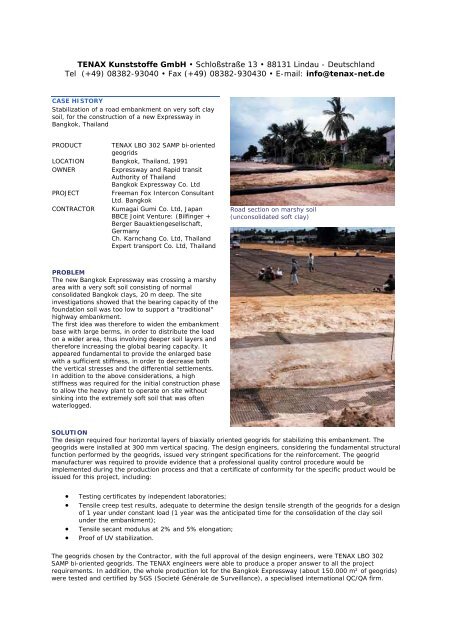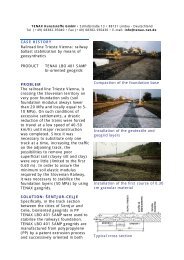TENAX Kunststoffe GmbH - extrudierte Netze und Gitter aus Kunststoff
TENAX Kunststoffe GmbH - extrudierte Netze und Gitter aus Kunststoff
TENAX Kunststoffe GmbH - extrudierte Netze und Gitter aus Kunststoff
You also want an ePaper? Increase the reach of your titles
YUMPU automatically turns print PDFs into web optimized ePapers that Google loves.
<strong>TENAX</strong> <strong><strong>Kunststoff</strong>e</strong> <strong>GmbH</strong> • Schloßstraße 13 • 88131 Lindau - Deutschland<br />
Tel (+49) 08382-93040 • Fax (+49) 08382-930430 • E-mail: info@tenax-net.de<br />
CASE HISTORY<br />
Stabilization of a road embankment on very soft clay<br />
soil, for the construction of a new Expressway in<br />
Bangkok, Thailand<br />
PRODUCT <strong>TENAX</strong> LBO 302 SAMP bi-oriented<br />
geogrids<br />
LOCATION Bangkok, Thailand, 1991<br />
OWNER<br />
Expressway and Rapid transit<br />
Authority of Thailand<br />
Bangkok Expressway Co. Ltd<br />
PROJECT<br />
Freeman Fox Intercon Consultant<br />
Ltd. Bangkok<br />
CONTRACTOR Kumagai Gumi Co. Ltd, Japan<br />
BBCE Joint Venture: (Bilfinger +<br />
Berger Bauaktiengesellschaft,<br />
Germany<br />
Ch. Karnchang Co. Ltd, Thailand<br />
Expert transport Co. Ltd, Thailand<br />
Road section on marshy soil<br />
(unconsolidated soft clay)<br />
PROBLEM<br />
The new Bangkok Expressway was crossing a marshy<br />
area with a very soft soil consisting of normal<br />
consolidated Bangkok clays, 20 m deep. The site<br />
investigations showed that the bearing capacity of the<br />
fo<strong>und</strong>ation soil was too low to support a "traditional"<br />
highway embankment.<br />
The first idea was therefore to widen the embankment<br />
base with large berms, in order to distribute the load<br />
on a wider area, thus involving deeper soil layers and<br />
therefore increasing the global bearing capacity. It<br />
appeared f<strong>und</strong>amental to provide the enlarged base<br />
with a sufficient stiffness, in order to decrease both<br />
the vertical stresses and the differential settlements.<br />
In addition to the above considerations, a high<br />
stiffness was required for the initial construction phase<br />
to allow the heavy plant to operate on site without<br />
sinking into the extremely soft soil that was often<br />
waterlogged.<br />
SOLUTION<br />
The design required four horizontal layers of biaxially oriented geogrids for stabilizing this embankment. The<br />
geogrids were installed at 300 mm vertical spacing. The design engineers, considering the f<strong>und</strong>amental structural<br />
function performed by the geogrids, issued very stringent specifications for the reinforcement. The geogrid<br />
manufacturer was required to provide evidence that a professional quality control procedure would be<br />
implemented during the production process and that a certificate of conformity for the specific product would be<br />
issued for this project, including:<br />
• Testing certificates by independent laboratories;<br />
• Tensile creep test results, adequate to determine the design tensile strength of the geogrids for a design<br />
of 1 year <strong>und</strong>er constant load (1 year was the anticipated time for the consolidation of the clay soil<br />
<strong>und</strong>er the embankment);<br />
• Tensile secant modulus at 2% and 5% elongation;<br />
• Proof of UV stabilization.<br />
The geogrids chosen by the Contractor, with the full approval of the design engineers, were <strong>TENAX</strong> LBO 302<br />
SAMP bi-oriented geogrids. The <strong>TENAX</strong> engineers were able to produce a proper answer to all the project<br />
requirements. In addition, the whole production lot for the Bangkok Expressway (about 150.000 m² of geogrids)<br />
were tested and certified by SGS (Societé Générale de Surveillance), a specialised international QC/QA firm.
Tab. 1<br />
Design specs for the geogrid<br />
Longitudinal Direction<br />
(MD)<br />
Tensile strength<br />
(95% lower confidence limit)<br />
17.5 kN/m 31.5 kN/m<br />
Elongation 12% 11%<br />
Transversal Direction<br />
(TD)<br />
Tab. 2<br />
Long term strength of <strong>TENAX</strong> LBO 302 SAMP geogrid for 1 year of continuous constant load at 20°C.<br />
Longitudinal Direction<br />
(MD)<br />
Tensile strength 4.70 kN/m 7.80 kN/m<br />
Transversal Direction<br />
(TD)<br />
tab. 3<br />
Characteristics measured by the Quality Control on the entire production lot of <strong>TENAX</strong> LBO 302<br />
SAMP geogrid<br />
Measured properties Mean value Standard deviation 95% Lower conf. limit<br />
Tensile strength TD 34.66 kN/m 1.19 kN/m 32.71 kN/m<br />
Yield point elongation TD 9.92% 2.57% ---<br />
Tensile mod. at 2% el. TD 608 kN/m 50.3 kN/m 525 kN/m<br />
Tensile mod. at 5% el. TD 476 kN/m 29.2 kN/m 429 kN/m<br />
Tensile strength MD 19.8 kN/m 0.59 kN/m 18.85 kN/m<br />
Yield point elongation MD 19.15% 0.66% ---<br />
Tensile mod. at 2% el. MD 325 kN/m 18.3 kN/m 295 kN/m<br />
Tensile mod. at 5% el. MD 234 kN/m 9.4 kN/m 180 kN/m<br />
CONCLUSIONS<br />
<strong>TENAX</strong> geogrids in this project, as well as in many others, have proven to be a product with the highest technical<br />
characteristics and with guaranteed properties. <strong>TENAX</strong> LBO 302 SAMP passed severe controls before being<br />
utilized as a structural element for the stabilization of an embankment on very soft soil. The ease of installation<br />
of <strong>TENAX</strong> geogrids allowed the Contractor to maintain high installation rates and allowed to use an innovative<br />
technology for stabilizing the embankment, thus obtaining consistent savings over traditional solutions.




